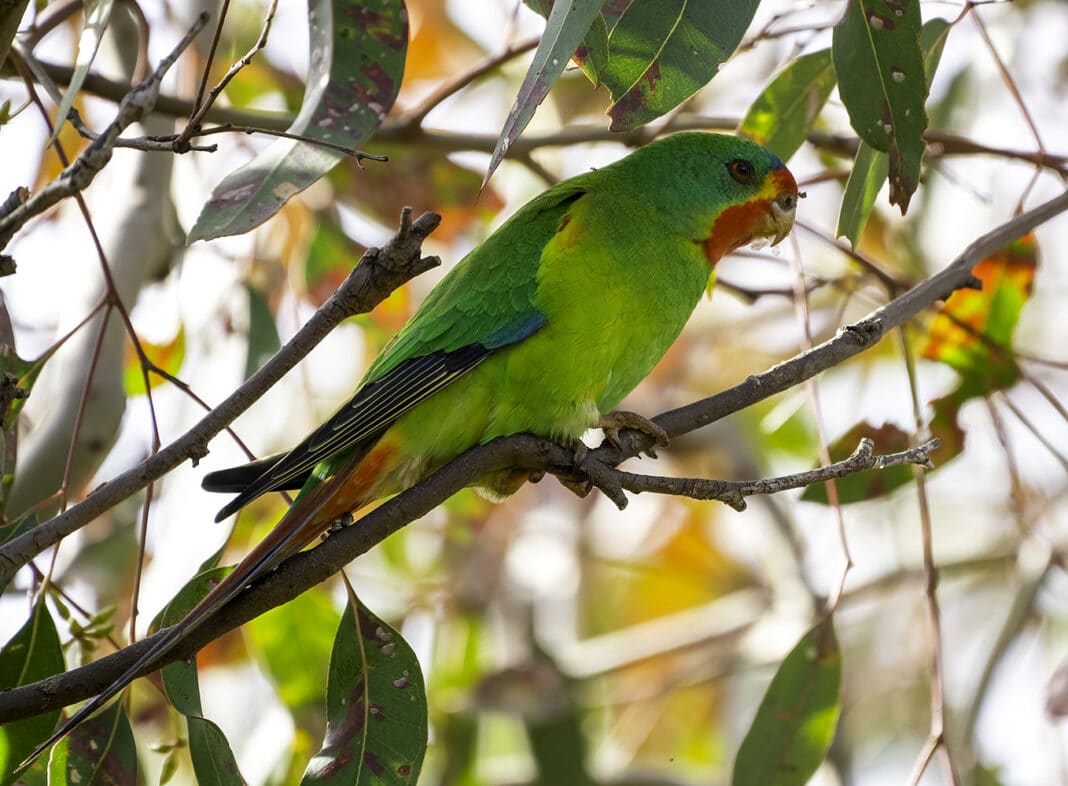The Australian Government has released a new Recovery Plan to boost the long-term survival of the Swift Parrot.
The new Plan coincided with Australia’s Threatened Species Day, which raises awareness of more than 2,000 plants and animals at risk of extinction.
It acknowledges the death of the last remaining Thylacine, or Tasmanian Tiger, at Hobart Zoo in 1936.
On Thursday, the Australian Government released the new Plan, which will see AU $1.3 million committed to conservation projects funded by the Federal and State Governments connected to the Parrot’s protection and breeding zones.
As announced by Tanya Plibersek, the Minister for the Environment, “the swift parrot is one of just two migratory parrots in the world.”
Minister Plibersek said protection and recovery of the Swift Parrot requires the cooperation of state and local governments and support for on-the-ground work in local communities.
So far, the Tasmanian and Queensland governments have signed onto the Plan, with invitations extending to New South Wales and Victoria to join the Plan.
In 2016, the Swift Parrot was listed as critically endangered and is one of 110 species prioritised under the Australian Government’s Threatened Species Action Plan.
Once found widely across eastern Australia, only about 750 mature birds remain in the wild.

Studies have found that the species could be extinct within ten years if governments failed to do more to protect it.
“They breed in Tasmania during the summer and then fly across the Bass Strait during the winter,” Ms Plibersek said.
“While their rainbow feathers were once common across southeastern Australia, they are now critically endangered due to population decline.
“This new Recovery Plan will help all governments protect and revive this iconic species. It will help protect them from predators, support their habitats, and promote their future breeding.”

Key conservation groups have criticised the new Plan
As reported in the Guardian Australia, conservation groups and scientists connected with developing the Plan said it has failed to address the critical threat to the species’ survival: the harvesting of native forests.
The stakeholders who participated in the Swift Parrot Recovery Team said the last official draft they had received was a version released for public comment in 2019.
They first saw the latest Plan after it was provided by Guardian journalists seeking expert feedback on the new Plan on Thursday.
The Guardian reports that the Environment Department said the Plan is still “being finalised” and will be published in “coming weeks”.
According to Mic Roderick, a BirdLife Australia representative on the team, “The crux of the issue is the minister put out a media release saying the recovery plan has been released, and yet no one on the recovery team had seen it.”
“One would expect that recovery team members would see a purported or apparent final version before it is released and before the media has access to it.”
Dr Dejan Stojanovic, a conservation scientist at the Australian National University and a team member for over a decade, said a version of the Plan had not been circulated for years.
He said members have been left “sidelined” with key recommendations ignored.
The Guardian Australia revealed last year that Tasmanian and federal bureaucrats had pushed for the Plan to be changed to remove and play down the scientific evidence that native harvesting was the biggest threat to its survival.
The Tasmanian Government has its own swift parrot program, which it claims uses “a coordinated and adaptive approach.”
Wood Central understands that the Tasmanian program has allocated AU $1 million, which is separate from the National Program, which is committed to developing conservation covenants, auditing the health of parrots in captivity and collecting spatial habitat requirements.
After reading the latest version of the document, Dr Stojanovic said it focused too heavily on the threat of predation by sugar gliders instead of the critical danger of native harvesting.
Reforms could see Forestry Agreements comply with Environmental Laws
A spokesperson for Plibersek said the Plan had been “endorsed by the federal government’s independent threatened species scientific committee, which includes many of Australia’s most experienced and respected scientists”.
“The Government understood the environmental value of native forests,” the spokesperson said, with new reforms requiring regional forestry agreements (RFA’s) between the Government and states to comply with national environmental laws.
“The government takes the advice of experts about which projects should get environmental science funding,” the spokesperson said.
As reported in July, the Government is looking to include RFA’s in the new laws.
RFAs are federal-state deals that have effectively enjoyed an exemption from national environment laws on the basis that reserves and forest practice requirements are sufficient.
In effect, they are long-term plans for the sustainable management and conservation of Australia’s native forests.
There are 10 RFA’s in four states covering commercial native forestry regions – five in Victoria, three in New South Wales and one each in Western Australia and Tasmania.
In July, The Australian reported that drafts of the new standard encouraged conservationists.
“It could make logging under the RFAs nigh impossible,” said Wilderness Society Tasmania forest campaigner Alice Hardinge.
At the time, Ms Plibersek said the Government recognised the need for timber products and jobs but was determined to reform “broken” environmental laws.
“We know native forests are valuable for their carbon storage and native habitats including for endangered animals like koalas, Leadbeater’s possums and greater gliders,” Ms Plibersek said during an interview with The Australian.
“We are committed to reforming Australia’s environmental laws,” Ms Plibersek said, “these laws are broken.”
“They don’t protect our environment, and they don’t work for business.”
Whilst activists are “hopeful” that the laws will further protect endangered species and high-conservation forests, Australian Forest Products Association Chair Joel Fitzgibbon has warned against “misinformation from extreme activist groups”.
Mr Fitzgibbon, a former federal minister and colleague of Ms Plibersek, warns that curtailing native forestry will threaten the country’s “sovereign capability” to build homes and maintain a range of timber-based industries.
In February, Fitzgibbon, a former Agriculture and Forestry Minister, spoke of the importance of the “whole value chain to Australia’s economic independence.”






